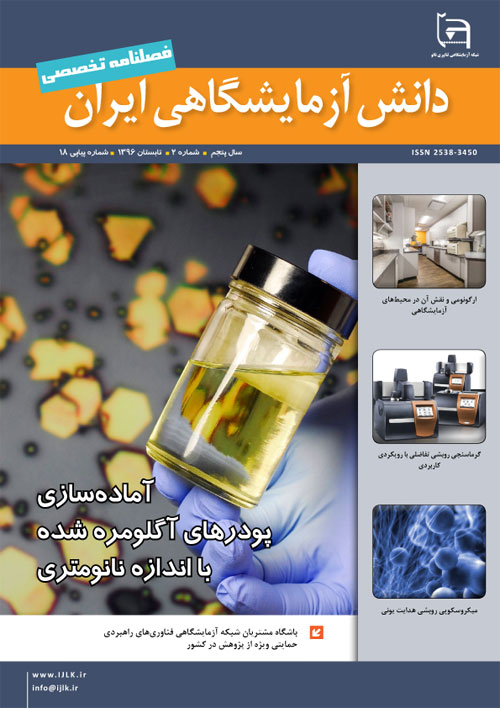فهرست مطالب

مجله دانش آزمایشگاهی ایران
سال پنجم شماره 2 (پیاپی 18، تابستان 1396)
- 40 صفحه،
- تاریخ انتشار: 1396/06/20
- تعداد عناوین: 6
- اخبار
- استاندارد
- مقالات
-
صفحه 24
-
Page 5
Ergonomics or human factors engineering is to try a combination of tools, devices, work environment and jobs due to physical abilities - intellectual and limitations and human interests, the design. This science with the aim of increasing productivity, with the health, safety and well-being in the workplace, is formed Neglecting the principles of ergonomics in laboratories reduces the efficiency and increase the stress of employees. The use in the workplace can lead to elimination or reduction of injuries and health problems and lead to job safety and increase efficiency in the lab. ILO, the term ergonomics is meant to fit the job is defined to humans. Lab managers could also provide proper safety by applying ergonomics to increase the quality and quantity of staff in providing laboratory services to their clients. The main objective of this paper is ergonomic laboratory.
Keywords: ergonomics, workplace, employee performance, employee safety -
Page 11
Imaging with scanning electron microscope, is important to achieve high quality images. The sample preparation is an effective step to have favorable images. Powders preparation for scanning electron microscopy requires experience and knowledge in this field and in most cases initial preparation can facilitate imaging in next steps. In this paper, after a glimpse of the preparation of powders, powders categorized into two groups: micron and submicron powders (nanometer range). How proper preparation and presentation of each application steps for the elimination of powder agglomeration problems have been explained.
Keywords: scanning electron microscope, powder preparation, agglomeration -
Page 15
Methods of thermal analysis and among the most widely used of them, DSC, in terms of design and manufacturing processes and measuring properties of products is very important. According to the theory of the ICTAC, differential scanning calorimetry is a thermal analysis method, in which a sample is exposed to a controlled temperature change, how to change its thermal properties as a function of temperature continuously will be measured. In this paper, the definitions and principles of this method in addition to its widely usages will be discussed, then DSC calorimeter will be introduces and parameters that can be calculated by this method, selection of crucibles suitable for each test sample according to types of samples in terms of physical condition as well as crucibles for special tests, test data, improve and optimization of them with the results of a study using the Taguchi method optimizer, new methods of DSC, methodology and applications and a variety of related devices, will be studied. From the obtained results of the application of Taguchi method we can understand, identification of optimal scanning speed, type of proper crucibles, type and rate of operator gas, temperature gradient that is created and the time it takes to cross the crucible wall are effective in accuracy of measured data and power of results.
Keywords: Thermal Analysis, Differential Scanning Calorimetry, Heat Flow, Crucible, Test Data -
Page 24
Concerning the nature of the work, fire in Nano labs is different from other types of fire, especially in the field of combustible materials. In fact, because of the existence of different types of high combustible chemicals in Nano labs, the potential of firing is high. Meanwhile in other labs, because of larger particles, it is less likely. Negligence about working with chemicals in Nano labs and the lack of personnel awareness in this field can cause explosion or widespread fires, therefore very serious damages will be made for the personnel, the constructions of laboratories and the equipment.
Keywords: Scanning ion conductance microscopy, living cell, micro pipetteprobe, Electrophysiology


